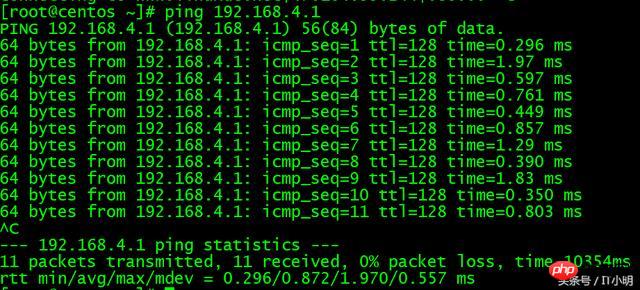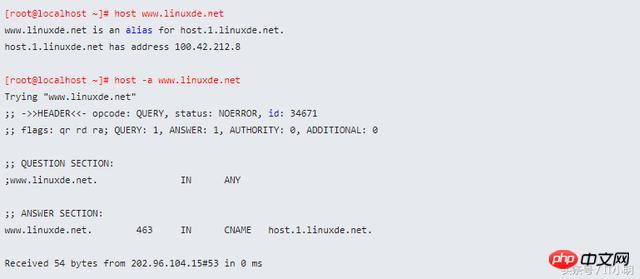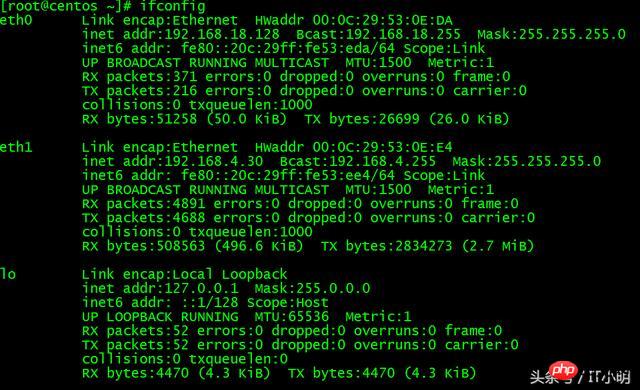Top 10 network commands under Linux
In order to better use Linux, we must know some necessary network commands of Linux and better understand the performance of Linux.
1. curl
The curl command is a file transfer tool that uses URL rules to work under the command line. It supports file upload and download, so it is a comprehensive transmission tool. However, according to tradition, curl is called a download tool. As a powerful tool, curl supports many protocols including HTTP, HTTPS, ftp, etc. It also supports features such as POST, cookies, authentication, downloading partial files from specified offsets, user agent strings, speed limits, file sizes, progress bars, etc. . To automate web page processing and data retrieval, curl can help.
The curl command can be used to perform operations such as downloading, sending various HTTP requests, and specifying HTTP headers. If the system does not have curl, you can use yum install curl to install it, or you can download and install it. curl outputs the downloaded file to stdout and outputs the progress information to stderr. Use the --silent
option to not display progress information.
curl URL --silent
2. wget
The wget command is used to download files from the specified URL. wget is very stable, and it has strong adaptability in situations with very narrow bandwidth and unstable networks. If the download fails due to network reasons, wget will continue to try until the entire file is downloaded. If the server interrupts the download process, it will contact the server again and continue downloading from where it stopped. This is useful for downloading large files from servers that have limited connection times.

3. ping
The ping command is used to test the network connectivity between hosts. Executing the ping command will use the ICMP transport protocol to send a message requesting a response. If there is no problem with the network function of the remote host, it will respond to the message, thus knowing that the host is operating normally.

4. traceroute
The traceroute command is used to trace the entire path of data packets when they are transmitted on the network. The default packet size sent is 40 byte.
Through traceroute we can know the path that information takes from your computer to the host at the other end of the Internet. Of course, the path a data packet takes from the same starting point (source) to the same destination (destination) may be different every time, but basically the route taken is the same most of the time.
traceroute measures how long it takes by sending small packets to the destination device until it returns. Each device on a path is traceroute tested three times. The output includes the time (ms) of each test and the name of the device (if any) and its IP address.

5. The host
host command is a commonly used analysis domain name query tool and can be used to test whether the domain name system is working properly.

6. Whois
is used to find and display information related to the specified user account and domain name, including domain name registration time, owner, email, etc. Similar commands : tracepath, host, nslookup, who, pwd.

7. ifplugstatus
The ifplugstatus command can tell you whether there is a network cable plugged into the network interface. This command is not pre-installed in Ubuntu. Use the following command to install it
sudo apt-get install ifplugd
This command can view the status of all network interfaces or the status of a specified network interface
8. ifconfig
The ifconfig command is used to configure and display the network parameters of the network interface in the Linux kernel. The network card information configured with the ifconfig command will no longer exist after the network card is restarted and the machine is restarted. If you want to store the above configuration information in your computer forever, you need to modify the configuration file of the network card.

9. ifdown/ifup
The ifdown command is used to disable the specified network interface. The ifup command is used to start the specified network interface;
10. netstat
The netstat command is used to print the status information of the network system in Linux, allowing you to know the network status of the entire Linux system.

Hot AI Tools

Undresser.AI Undress
AI-powered app for creating realistic nude photos

AI Clothes Remover
Online AI tool for removing clothes from photos.

Undress AI Tool
Undress images for free

Clothoff.io
AI clothes remover

AI Hentai Generator
Generate AI Hentai for free.

Hot Article

Hot Tools

Notepad++7.3.1
Easy-to-use and free code editor

SublimeText3 Chinese version
Chinese version, very easy to use

Zend Studio 13.0.1
Powerful PHP integrated development environment

Dreamweaver CS6
Visual web development tools

SublimeText3 Mac version
God-level code editing software (SublimeText3)

Hot Topics
 1386
1386
 52
52
 Difference between centos and ubuntu
Apr 14, 2025 pm 09:09 PM
Difference between centos and ubuntu
Apr 14, 2025 pm 09:09 PM
The key differences between CentOS and Ubuntu are: origin (CentOS originates from Red Hat, for enterprises; Ubuntu originates from Debian, for individuals), package management (CentOS uses yum, focusing on stability; Ubuntu uses apt, for high update frequency), support cycle (CentOS provides 10 years of support, Ubuntu provides 5 years of LTS support), community support (CentOS focuses on stability, Ubuntu provides a wide range of tutorials and documents), uses (CentOS is biased towards servers, Ubuntu is suitable for servers and desktops), other differences include installation simplicity (CentOS is thin)
 How to use docker desktop
Apr 15, 2025 am 11:45 AM
How to use docker desktop
Apr 15, 2025 am 11:45 AM
How to use Docker Desktop? Docker Desktop is a tool for running Docker containers on local machines. The steps to use include: 1. Install Docker Desktop; 2. Start Docker Desktop; 3. Create Docker image (using Dockerfile); 4. Build Docker image (using docker build); 5. Run Docker container (using docker run).
 How to install centos
Apr 14, 2025 pm 09:03 PM
How to install centos
Apr 14, 2025 pm 09:03 PM
CentOS installation steps: Download the ISO image and burn bootable media; boot and select the installation source; select the language and keyboard layout; configure the network; partition the hard disk; set the system clock; create the root user; select the software package; start the installation; restart and boot from the hard disk after the installation is completed.
 Centos options after stopping maintenance
Apr 14, 2025 pm 08:51 PM
Centos options after stopping maintenance
Apr 14, 2025 pm 08:51 PM
CentOS has been discontinued, alternatives include: 1. Rocky Linux (best compatibility); 2. AlmaLinux (compatible with CentOS); 3. Ubuntu Server (configuration required); 4. Red Hat Enterprise Linux (commercial version, paid license); 5. Oracle Linux (compatible with CentOS and RHEL). When migrating, considerations are: compatibility, availability, support, cost, and community support.
 How to view the docker process
Apr 15, 2025 am 11:48 AM
How to view the docker process
Apr 15, 2025 am 11:48 AM
Docker process viewing method: 1. Docker CLI command: docker ps; 2. Systemd CLI command: systemctl status docker; 3. Docker Compose CLI command: docker-compose ps; 4. Process Explorer (Windows); 5. /proc directory (Linux).
 Detailed explanation of docker principle
Apr 14, 2025 pm 11:57 PM
Detailed explanation of docker principle
Apr 14, 2025 pm 11:57 PM
Docker uses Linux kernel features to provide an efficient and isolated application running environment. Its working principle is as follows: 1. The mirror is used as a read-only template, which contains everything you need to run the application; 2. The Union File System (UnionFS) stacks multiple file systems, only storing the differences, saving space and speeding up; 3. The daemon manages the mirrors and containers, and the client uses them for interaction; 4. Namespaces and cgroups implement container isolation and resource limitations; 5. Multiple network modes support container interconnection. Only by understanding these core concepts can you better utilize Docker.
 What to do if the docker image fails
Apr 15, 2025 am 11:21 AM
What to do if the docker image fails
Apr 15, 2025 am 11:21 AM
Troubleshooting steps for failed Docker image build: Check Dockerfile syntax and dependency version. Check if the build context contains the required source code and dependencies. View the build log for error details. Use the --target option to build a hierarchical phase to identify failure points. Make sure to use the latest version of Docker engine. Build the image with --t [image-name]:debug mode to debug the problem. Check disk space and make sure it is sufficient. Disable SELinux to prevent interference with the build process. Ask community platforms for help, provide Dockerfiles and build log descriptions for more specific suggestions.
 What computer configuration is required for vscode
Apr 15, 2025 pm 09:48 PM
What computer configuration is required for vscode
Apr 15, 2025 pm 09:48 PM
VS Code system requirements: Operating system: Windows 10 and above, macOS 10.12 and above, Linux distribution processor: minimum 1.6 GHz, recommended 2.0 GHz and above memory: minimum 512 MB, recommended 4 GB and above storage space: minimum 250 MB, recommended 1 GB and above other requirements: stable network connection, Xorg/Wayland (Linux)




